RCD Espanyol is in form over the course of 2020/21 Segunda Division. However, this was a tight game in the first half. Both teams created some chances. However, in the second half, especially after the 70th minutes, RCD Espanyol had more chances and eventually scored the winning goal.
In this tactical analysis, we shall examine the tactics for both sides, RCD Espanyol and CE Sabadell. In this analysis, we shall dissect the tactics that eventually affected the game.
Lineups
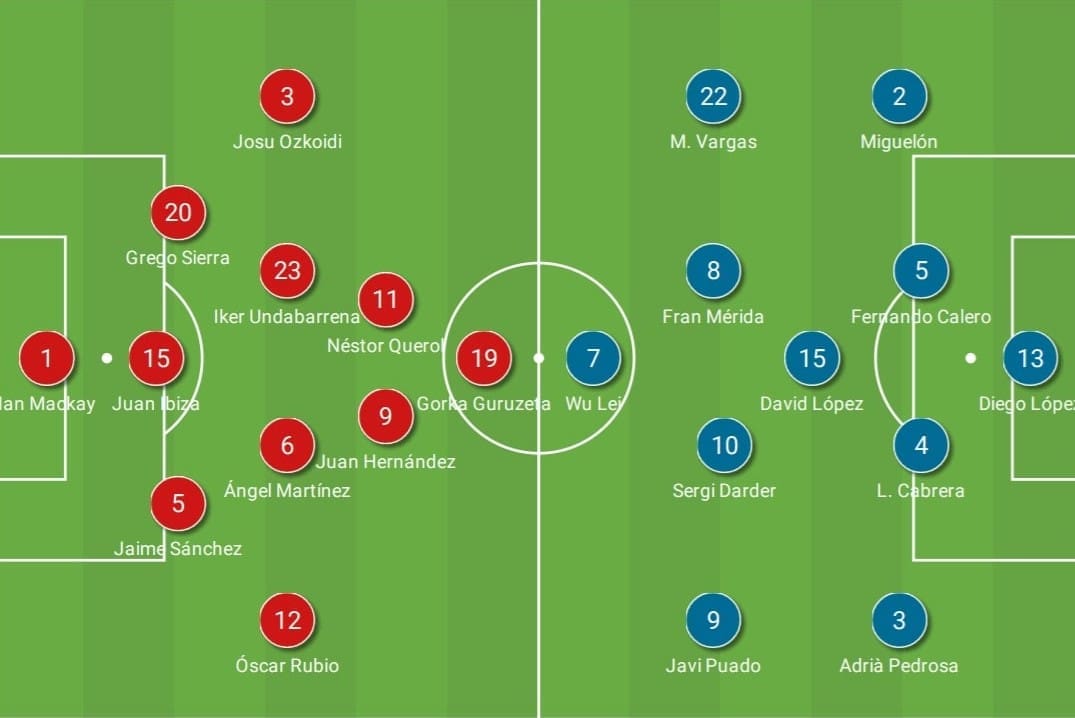
CE Sabadell: Juan Mackay, Jaime Sánchez, Juan Fernández, Grego Sierra, Óscar Rubio, Ángel Martínez, Iker Undabarrena, Josu Ozkoidi, Juan Hernández, Néstor Querol, Gorka Guruzeta
RCD Espanyol: Diego López, Miguelón, Fernando Calero, Leandro Cabrera, Adrià Pedrosa, David López, Fran Mérida, Adri Embarba, Darder, Wu Lei, Javi Puado
How RCD Espanyol created chances
As mentioned above, in the first half this was a tight game as both sides managed to create some chances. Thus, in this section, we’ll delve into how RCD Espanyol created chances before they made some adjustments.
Normally, Espanyol play short when they try to build up from the back. For the past three games, they all played short in playing out and the defensive shapes they encountered are all flat 1-4-4-2. Hence, they already knew how to deal with this defensive shape very well. They would normally deploy a “number six”- Lopéz, and a “number eight”’- Mérida as the target players to bringing the play into the next stage.
However, CE Sabadell pressed high and utilised a different shape to interrupt Espanyol’s standard build-up process. A diamond 1-4-4-2 was deployed when Sabadell pressed high in the first half. This shape intended to prevent Espanyol from getting the ball to the target players feet, as well as closing the centre. Then Sabadell would try to force the ball-carrier to commit mistakes as he would have no near passing options.
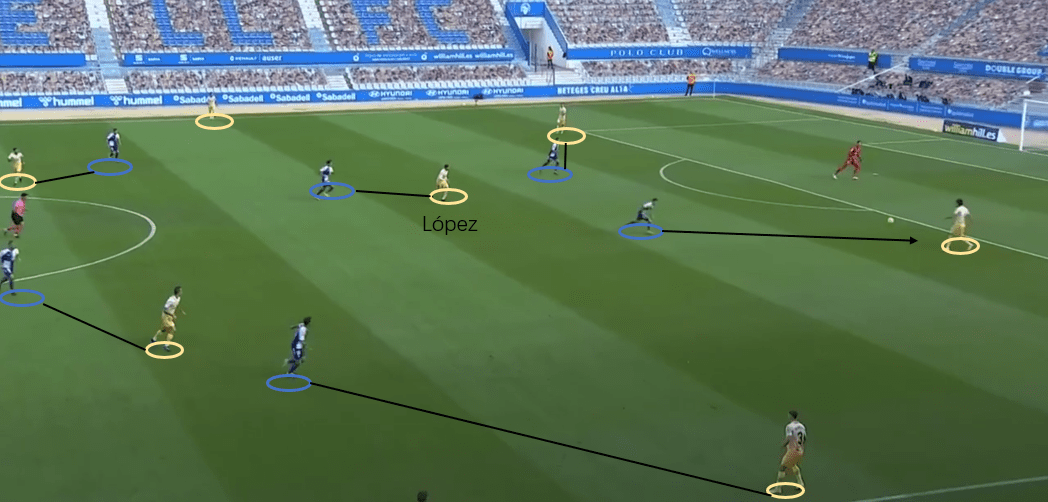
The above image manifested how Sabadell pressed Espanyol’s 2-3-2 offensive shape in a diamond 4-2 shape. Two strikers were responsible for Espanyol’s centre-back pair. The player at the tip of the diamond, Undabarrena, tracked the “number six” Lopéz, eliminating the possible passing channels to directly pick him.
As the ball was released by the goalkeeper to the left centre-back Cabrera, the rest of the diamond shifted across the field with these responsibilities: Rubio, the right tip of the diamond, shifted to mark the left-back Pedrosa. The bottom of the diamond Martinez marked the “dropping number ten” Darder, and the left of the diamond Querol marked “the number eight” Mérida. The right-back on the weak side was left unmarked. With these matching-ups, it was difficult for Espanyol to play short to find target players and the ball-carrier was forced into mistakes.
However, as Sabadell pressed so high, the space behind their defensive line was huge. On top of this, one of their defenders will step up to the midfield to secure the marking job on midfielders was done. So, this would leave a 3v3 situation in the backline, and this numeral equality situation is always favourable to the attacking side. Also, their centre-backs Fernandéz and Sierra were no fast in turning and chasing, and this would further deteriorate the success rate of their defending.
Therefore, acknowledging these factors, Espanyol didn’t insist on playing short but seize the timing to play more direct to take advantage of the 3v3 scenario. If they couldn’t be the first to access the ball, with the likes of Wu Lei and Embarba, who are mobile and pacey, second ball/ free ball could be collected with high success rate.
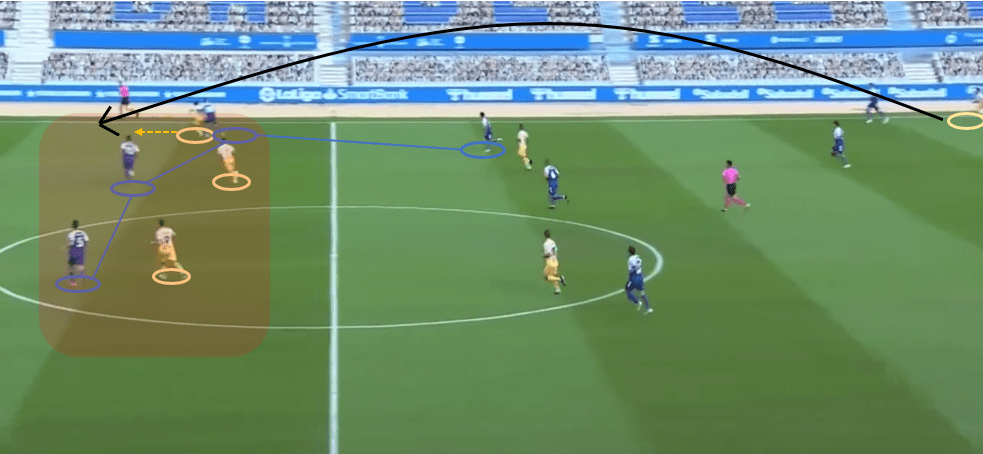
From the above example, the right-back Miguelón saw a stepping defender of Sabadell into the midfield. Therefore, a 3v3 scenario with the defensive line was created. This was the trigger to play long and Miguelón’s long pass aiming at the space behind was won by Embarba directly attacking the goal. Sierra was outpaced by Embarba and a chance was therefore created.
Apart from this, when Espanyol could successfully made it into the middle third and faced forwards, they would try to play diagonally to exploit the space behind the full-back on the weak side. This was done when the Sabadell dropped to form the mid-block compactly. Space was therefore around the block.
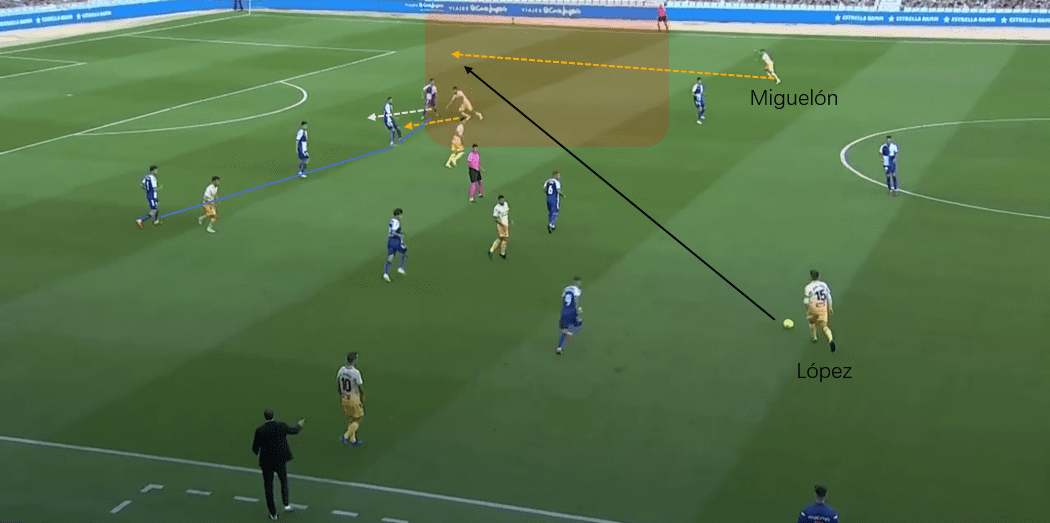
In the above image, you could see a compressed block of Sabadell clustering in the centre. The space on the flank was huge and available for the right-back to utilise. As López and Miguelón made the eye contact, Embarba ran diagonally towards the box to decoy the opponent’s left-back to follow him, freeing more space on the flank for Miguelón to exploit. Sabadell’s left midfielder Querol didn’t scan around and didn’t track Miguelón on his weak side. Therefore, Miguelón enjoyed a lot of space and time to hit the final pass of high quality.
How CE Sabadell created chances
While Espanyol was hard to play short to build up, it was completely the opposite for CE Sabadell. Sabadell was playing more like a 1-3-4-1-2 shape in attack. They tried to take advantage of 1-4-2-3-1 defensive shape in the first place, enticing the striker committing to press the goalkeeper and wingers to step on defenders. This could free the side-back and progressed the play.
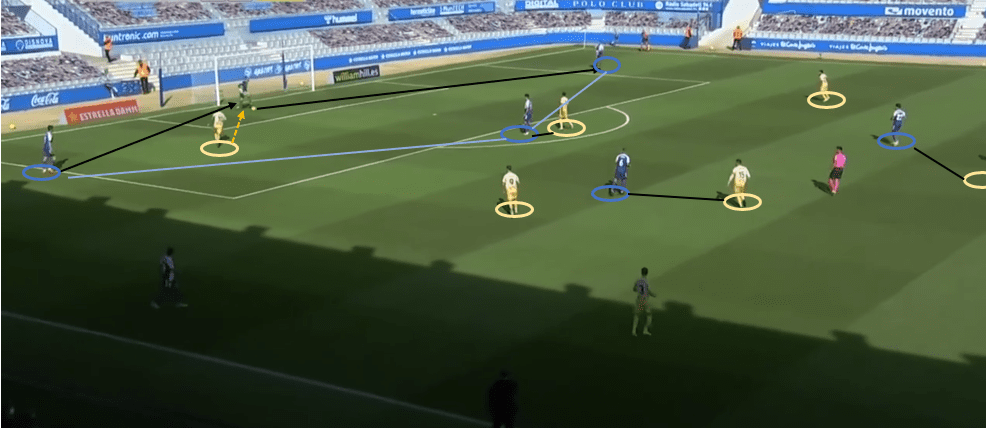
The above image manifested how they got this done. The right-back/right centre-back Sánchez in this case picked the goalkeeper, instigating the opponent´s striker to press on the goalkeeper. The rest of the Espanyol players marked their matchup, while the right-winger Embarba marked the left centre-back Sierra.
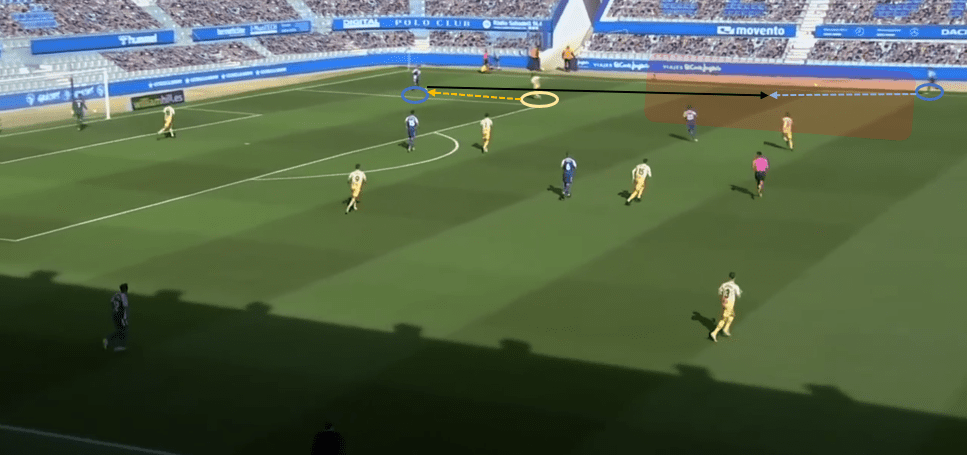
Then Sierra was picked by the goalkeeper, taking extras touches to entice Embarba to step. He absorbed pressure from Embarba, freeing space for the left side-back Ozkoidi and then picked him. Ozkoidi was completely unmarked and able to progress the play. Then he hit a high-quality cross in front with lots of openings.
As Espanyol’s original 1-4-2-3-1 shape couldn’t work, they changed the defensive scheme later. They deployed three men in the front line: Wu Lei, Darder, Puado. They matched up with the three-back. The right-winger Embarba dropped to the next line mark the left side-back, with two pivots tracking two pivots of Sabadell. Espanyol sat in the mid-block to screen forward passes and intended to wait for some errant passes as cues to press the ball.
Nevertheless, Sabadell in this case would drop one more body to the midfield area. That may be the striker, Hernández. This would create a 3v2 scenario against Espanyol’s pivot-duo in the central midfield area, a free player would be created.
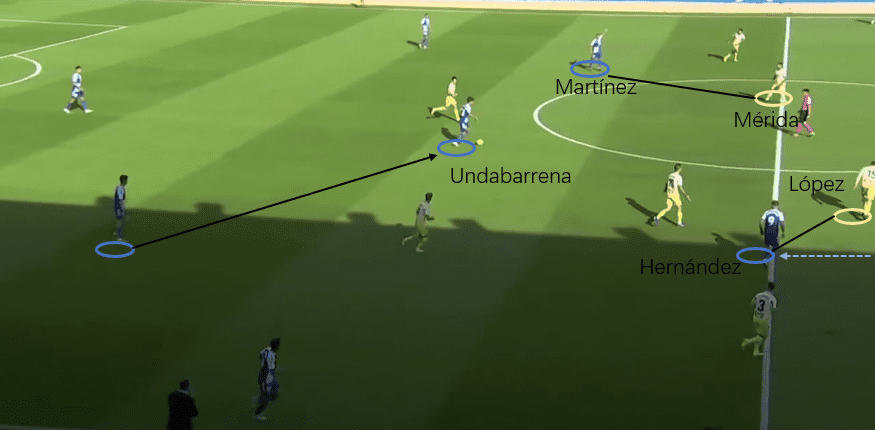
In the above example, the front three weren’t pressing in good structure with Darder’s positioning a bit off. In this case, Hernández dropped to “pin” Espanyol’s López, and Martínez also “fixed” the other pivot Mérida. Undabarrena was unmarked due to this matchup and the right centre-back could pick him with a simple pass. He turned and faced forwards, bringing the play into the next stage.
Determinant factors in the second half
With the tight game in the first half, Espanyol managed to dominate the second half, especially after 70th minutes with new substituted players on the pitch.
However, before the 70th minute, Espanyol also had some small changes in playing out tactics. The prominent one was the positioning and off-the-ball movement of two pivots. “Number eight” no longer stayed in front of the opponent’s midfield line. Instead, he came in the same vertical zone with “number six”, trying to overload the marker of the “number six”. This would force the marker, the tip of the diamond to make the decision, and potentially stretched the tip to deeper places, creating space for the “number six” to receive.
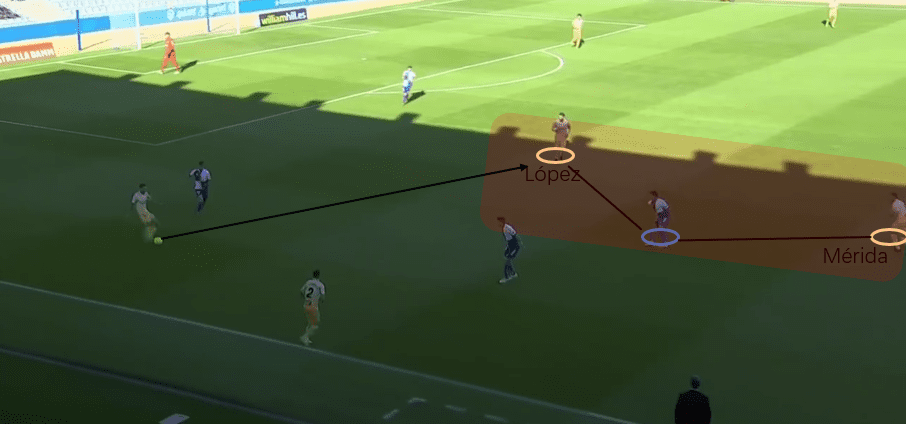
As we can see from the image, “number eight” Mérida and “number six” López stayed in the same vertical zone, overloading the marker of López, Unabarrena. Unabarrena in this case was interfered by Mérida´s positioning. Thus, he couldn´t step up to mark López tight. Otherwise, a channel to Mérida would appear. He was forced to stay in a balanced position between these two, and López had the space to be directly picked by the centre-back. Then the patterns of short playing could be performed as usual.
Now let’s discuss the influence of the substituted players. Goal-scorer Nico Melamed is an in-behind runner on the half-space. He could serve as a killer pass option in a well-timed manner and the starting eleven didn´t encompass this element. Óscar Gil could provide more changes than Miguelón, as Miguelón was more like a rigid crosser. Raúl de Tomás´s link-up play is extraordinary as he could not only pick the teammate with linking pass accurately, but also his dropping movement could create space in behind.
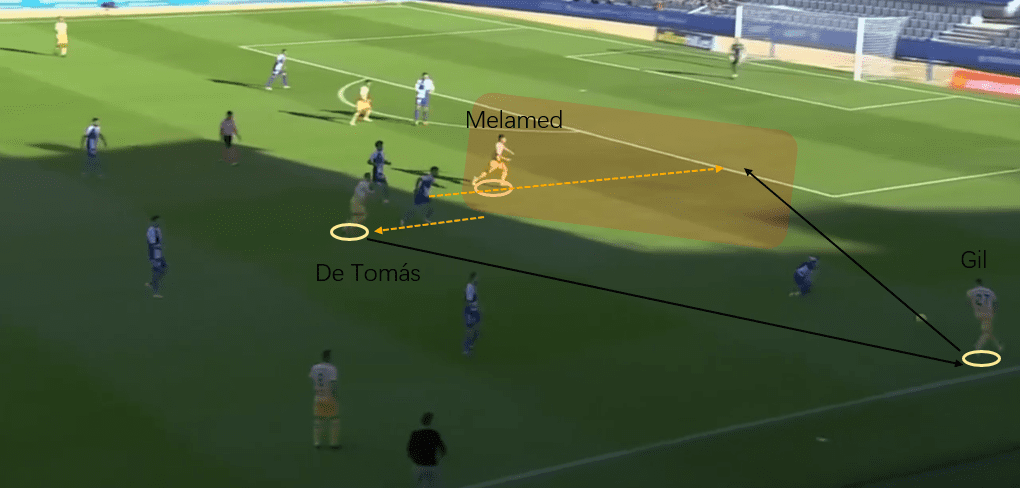
Above is an example of the combination of these three. De Tomás dropped well-timed to receive the pass, and his marker tracked him. This created space in behind. De Tomás latched onto the ball and picked Gil on the right in one touch. As the pass was executed, Melamed recognised the space de Tomás created and did a third-man in-behind run into that space. Then Gil also picked Melamed in one touch, sending the ball into the box.
Conclusion
RCD Espanyol is in form recently. They’ve proved that they could break the press regardless of the opponent’s defensive shape. If they could carry on with this form, they are likely to return to La Liga to compete with teams like Real Madrid and Barcelona.





Comments